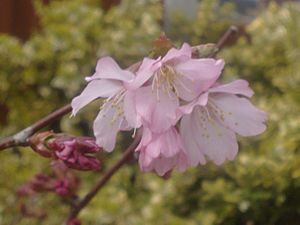Prunus nipponica facts for kids
Quick facts for kids Prunus nipponica |
|
|---|---|
 |
|
| Scientific classification | |
| Synonyms | |
|
The Japanese alpine cherry (Prunus nipponica), also called Takanezakura (高嶺桜), is a beautiful shrub. It comes from the islands of Hokkaidō and Honshū in Japan. This plant can grow up to about 16 feet (5 meters) tall. It is very tough and can grow in different types of soil. These include sandy, loamy, and clay soils.
Contents
About the Japanese Alpine Cherry
This cherry tree is one of the strongest types of cherry trees. It can handle very cold weather well. Its flowers are a very light pink or even white. They bloom in the first half of spring.
What the Flowers and Leaves Look Like
The flowers have 5 petals. Each flower is about 1.2 inches (3 cm) wide. The central part of the flower, called the pistil, is usually longer than the pollen-producing parts, called stamens.
The leaves of the Japanese alpine cherry are serrated, meaning they have jagged edges like a saw. The tree's bark is gray. In autumn, the leaves turn bright yellow and orange-red. These colors are quite rare for a cherry tree.
Special Chemicals and Uses
The wood of Prunus nipponica contains special natural chemicals called flavonoids. These include substances like catechin and naringenin.
Like other plants in the Prunus family, this cherry tree contains chemicals called amygdalin and prunasin. When these chemicals mix with water, they can form hydrocyanic acid. This acid is poisonous. However, in very tiny amounts, it is thought to help with breathing, digestion, and general well-being. The fruit of this tree can be eaten. It can also be used to make a green dye.
Where it Comes From and Its Protection
The Japanese botanist Jinzō Matsumura first wrote about this species in 1901. He published his findings in the Tokyo Botanical Magazine. Prunus nipponica belongs to the Pseudocerasus section of the cherry subgenus Cerasus. These are often grown as ornamental plants.
The Japanese alpine cherry is an important plant. It is on the "List of Protected Animals and Plants in the Wildlife Protection Zone." This zone is part of the Shirakami-Sanchi World Heritage Site. This means the plant is protected in this special wilderness area.
Varieties of the Japanese Alpine Cherry
There are a few different types, or varieties, of Prunus nipponica. These include:
- P. nipponica var. nipponica
- P. nipponica var. kurilensis
- P. nipponica var. Chishima-zakura

